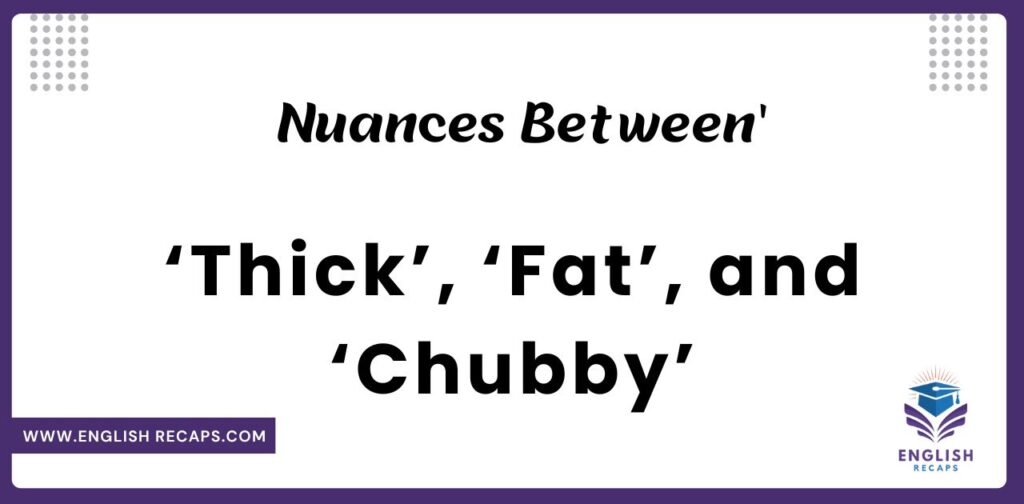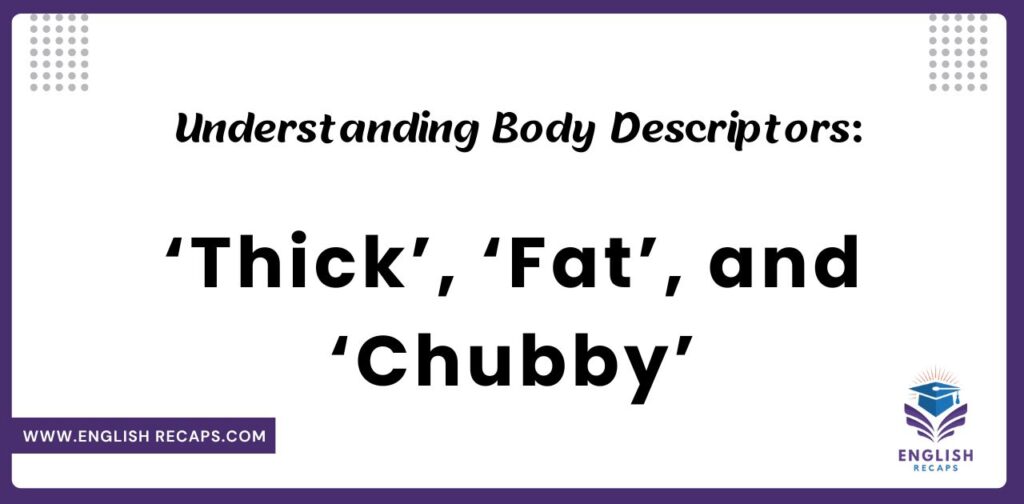Ever caught yourself fumbling for words when describing someone’s body type? You’re not alone. In today’s world, terms like ‘thick’, ‘fat’, and ‘chubby’ get tossed around a lot, but what do they really mean?
‘Thick’ often refers to a curvy, muscular build. ‘Fat’ simply means having more body fat, though it can be loaded with negative assumptions. ‘Chubby’ usually describes someone slightly plump, often in an endearing way.
But here’s the thing: these words carry weight (pun intended). They can shape how we see ourselves and others. So, let’s dive into what these terms really mean and how to use them respectfully. It’s time to get body-savvy!
Decoding Body Type Terminology: ‘Thick’, ‘Fat’, ‘Chubby’
Before we jump in, let’s get one thing straight: bodies come in all shapes and sizes, and every single one is worthy of respect. That said, the words we use to describe them can carry a lot of weight (another pun sorry, not sorry!). So, let’s break down these terms and see what they really mean in today’s context.
Defining ‘Thick’ in Modern Context
Picture this: you’re scrolling through social media, and you come across a post praising someone for being ‘thick’. What’s the first thing that comes to mind? If you’re thinking curves in all the right places, you’re on the right track.
In today’s lingo, ‘thick’ usually refers to a body type that’s curvy and well-proportioned, often with a smaller waist and fuller hips, thighs, and/or bust. It’s generally seen as a compliment, associated with a voluptuous figure that’s strong and healthy-looking.
But here’s the kicker: ‘thick’ doesn’t necessarily mean overweight. In fact, many people described as ‘thick’ are actually quite fit, with solid muscle underneath those curves. Think of celebrities like Beyoncé or Jennifer Lopez – they’re often described as ‘thick’ in a way that’s meant to be flattering.
Key points about ‘thick’:
- Usually seen as positive
- Implies curves and muscle
- Often associated with an hourglass figure
- Doesn’t necessarily mean overweight
‘Fat’: A Sensitive Descriptor with Cultural Weight
Now, let’s tackle the elephant in the room – ‘fat’. This three-letter word packs a punch, doesn’t it? Unlike ‘thick’, ‘fat’ is often viewed negatively in many cultures, particularly Western ones.
Technically, ‘fat’ simply refers to having a high amount of adipose tissue (that’s body fat to you and me). But in everyday use, it’s loaded with cultural baggage. It’s often used as an insult, associated with laziness, lack of self-control, or poor health – even though we know these stereotypes are harmful and often inaccurate.
But here’s the thing: some people are reclaiming ‘fat’ as a neutral descriptor. They argue that fat is just a body type, not a moral failing. This body positivity movement is changing how we think about fatness, challenging the idea that being fat is inherently bad or unhealthy.
Remember:
- ‘Fat’ is often seen as negative, but this perception is changing
- It’s a descriptor of body composition, not character
- Some people use it as a neutral or even positive term
- Always be cautious and respectful when using this word
‘Chubby’: A Term of Endearment or Concern?
Ah, ‘chubby’ the word that walks a fine line between cute and condescending. It’s often used to describe someone who’s a bit plump, usually in a way that’s meant to be endearing. Think of a chubby-cheeked baby or a cuddly puppy.
When applied to adults, though, ‘chubby’ can be a bit more complicated. It’s generally seen as less harsh than ‘fat’, but it still implies that someone is carrying extra weight. It might be used affectionately by close friends or family, but coming from a stranger, it could feel insulting.
The tricky thing about ‘chubby’ is that it’s subjective. What one person considers chubby, another might see as perfectly average. And like ‘fat’, it’s a term that some people embrace while others reject.
Quick ‘chubby’ takeaways:
- Often seen as cuter or more affectionate than ‘fat’
- Can be endearing or insulting, depending on context
- Highly subjective term
- Use with caution, especially with people you don’t know well
The Psychological Impact of Body Labeling
Now that we’ve unpacked these terms, let’s talk about the elephant in the room – how these labels can mess with our heads. Because let’s face it, words have power, and the way we talk about bodies can have a huge impact on how we see ourselves and others.
Imagine you’re a kid, and you overhear someone describe you as ‘chubby’. Even if it’s meant affectionately, that label sticks. It becomes part of how you see yourself, maybe even shaping your relationship with food and exercise for years to come.
Or picture yourself as an adult, scrolling through social media and seeing post after post praising ‘thick’ bodies. If you don’t fit that mold, you might start to feel like your body type isn’t desirable or worthy of celebration.
These labels can contribute to a whole host of psychological issues:
- Low self-esteem: Constantly hearing negative body descriptors can make you feel less worthy or attractive.
- Body dysmorphia: This is when you become obsessed with perceived flaws in your appearance, often seeing yourself as much larger or less attractive than you really are.
- Eating disorders: The pressure to fit a certain body type can lead to unhealthy relationships with food and exercise.
- Anxiety and depression: Feeling like you don’t measure up to societal standards can take a serious toll on your mental health.
But it’s not all doom and gloom. Awareness of these issues is growing, and many people are pushing back against harmful body labeling. The body positivity movement encourages people to love and accept their bodies as they are, regardless of size or shape.
Remember, your worth isn’t determined by your body type or what labels others might apply to you. You’re so much more than that, and you deserve to feel comfortable and confident in your own skin.
Don’t miss out to read this blog:
‘Dry Snitching’ Slang Meaning: What Does It Even Mean?
Cultural Influences on Body Perceptions
Ever noticed how what’s considered ‘ideal’ in terms of body type can vary wildly depending on where you are in the world? That’s because our perceptions of body types are heavily influenced by culture. What’s seen as ‘thick’ in one part of the world might be considered ‘skinny’ in another.
How Global Regions View Body Shapes Differently
Let’s take a whirlwind tour around the globe to see how different cultures perceive body types:
- United States: While there’s a growing body positivity movement, there’s still often pressure to be thin. However, ‘thick’ body types with curves in the ‘right’ places are increasingly celebrated, especially in pop culture.
- Brazil: Curves are king (or queen) here. A fuller figure, especially a larger bottom, is often seen as highly attractive. The Brazilian butt lift didn’t become popular for nothing!
- South Korea: Thinness is often prized here, with a strong emphasis on slender figures. However, this is slowly changing with growing awareness of body diversity.
- Nigeria: In many Nigerian cultures, a fuller figure is associated with prosperity and good health. Being ‘thick’ or even what some might call ‘fat’ can be seen as attractive and desirable.
- France: The “French paradox” isn’t just about food – it extends to body image too. While thinness is often idealized, there’s also an appreciation for natural body types and a more relaxed attitude towards weight.
- Samoa: In traditional Samoan culture, a larger body size is often associated with high social status and is considered attractive.
These are broad generalizations, of course. Within each culture, there’s a wide range of individual preferences and attitudes. But it goes to show that there’s no one ‘right’ or ‘ideal’ body type it all depends on cultural context.
So next time you find yourself using terms like ‘thick’, ‘fat’, or ‘chubby’, remember that these words might mean something completely different to someone from another cultural background. It’s a good reminder to be mindful and respectful when discussing body types.
Fashion and Media’s Role in Body Image Terms
Ever catch yourself flipping through a magazine or scrolling through Instagram, suddenly feeling like your body just doesn’t measure up? You’re not alone. The fashion industry and media have long been major players in shaping how we talk about and perceive different body types.
For decades, the ideal body type pushed by mainstream media was often unrealistically thin. Terms like ‘heroin chic’ in the 90s celebrated an extremely slender look that was unattainable (and unhealthy) for most people. This led to a lot of negative self-talk and body image issues for folks who didn’t fit that mold.
But times, they are a-changin’. In recent years, there’s been a push for more diversity in body types represented in fashion and media. Here’s how the landscape is shifting:
- Plus-size representation: More and more fashion brands are expanding their size ranges and featuring plus-size models. This has helped normalize and celebrate larger body types, making terms like ‘curvy’ and ‘plus-size’ more common and accepted.
- The rise of ‘thick’: Thanks in part to celebrities like Kim Kardashian and Nicki Minaj, ‘thick’ body types with fuller hips and thighs have become more celebrated in mainstream media.
- Body positivity movement: Social media has given a platform to activists promoting body acceptance at every size. This has led to more diverse body types being represented in ads and on runways.
- Athleticism celebration: There’s been a shift towards celebrating strong, athletic body types, especially for women. This has helped broaden the definition of what’s considered attractive.
However, it’s not all smooth sailing. While there’s more diversity than ever before, there’s still a long way to go. Many argue that the fashion industry still favors certain body types over others, and that media representation isn’t truly inclusive yet.
Moreover, the rise of social media has brought its own challenges. While it’s given a platform to diverse voices, it’s also created new pressures. Filters, editing apps, and carefully curated feeds can create unrealistic standards that are just as harmful as traditional media.
So what can we do? Being aware of these influences is a great start. Remember that what you see in media isn’t always reality, and that all body types are worthy of respect and celebration. And when you’re using terms like ‘thick’, ‘fat’, or ‘chubby’, consider the impact media might have had on how you perceive these words.
Nuances Between ‘Thick’, ‘Chubby’, and ‘Fat’

Alright, let’s get into the nitty-gritty. We’ve thrown these terms around, but what are the real differences between ‘thick’, ‘chubby’, and ‘fat’? It’s not just about semantics – understanding these nuances can help us communicate more clearly and respectfully.
‘Thick’:
- Generally positive or neutral
- Implies curves and muscle
- Often associated with an hourglass figure
- Doesn’t necessarily mean overweight
- Example: “She’s got a thick build with strong legs and a curvy waist.”
‘Chubby’:
- Can be endearing or slightly negative, depending on context
- Implies softness and a bit of extra weight
- Often used for children or as a cute descriptor
- Less severe than ‘fat’
- Example: “He’s got adorably chubby cheeks.”
‘Fat’:
- Often seen as negative, though this is changing
- Implies a significant amount of body fat
- Can be used as a neutral descriptor by some
- More direct than ‘chubby’
- Example: “I’m fat, and that’s okay. It’s just a description of my body type.”
Remember, these terms can mean different things to different people. What one person considers ‘thick’ might be ‘chubby’ to another, or even ‘fat’ to someone else. It all depends on personal perspective and cultural context.
Here’s a quick comparison to help visualize the differences:
| Aspect | ‘Thick’ | ‘Chubby’ | ‘Fat’ |
| Connotation | Usually positive | Mixed | Often negative, but changing |
| Body composition | Curves + muscle | Soft, plump | Higher body fat |
| Usage | Compliment or neutral description | Can be endearing or slightly negative | Direct description, sometimes reclaimed as neutral |
| Cultural perception | Increasingly celebrated | Varies widely | Stigmatized in many cultures, but changing |
The key takeaway? These terms aren’t just about body size – they carry emotional and cultural weight too. So when you’re using them, consider not just what you mean, but how they might be received.
Don’t miss out to read this blog:
Newfound or New-Found or New Found? Understanding Regional Variations
Practical Tips on Using Body Descriptors Appropriately
Now that we’ve dived deep into the world of body descriptors, you might be wondering, “How do I actually use these terms without putting my foot in my mouth?” Great question! Let’s break it down with some practical tips.
Intentions and Implications: Choosing Words Carefully
- Consider the context: Is this a casual conversation with a close friend, or a more formal setting? The same word can have very different implications depending on the situation.
- Think about your relationship with the person: A term that’s okay coming from a best friend might be offensive coming from an acquaintance.
- When in doubt, don’t comment on someone’s body at all: Unless you’re specifically asked, it’s often best to avoid body descriptors altogether.
- Use neutral terms when necessary: If you need to describe someone’s body for practical reasons (like helping them find clothes that fit), stick to neutral terms like “larger size” or “petite.”
- Be aware of cultural differences: What’s considered a compliment in one culture might be offensive in another.
- Listen to how people describe themselves: If someone refers to themselves as ‘fat’ neutrally, it’s probably okay for you to use that term too. But if they never use that word, you shouldn’t either.
- Focus on health and ability, not size: Instead of commenting on someone’s body size, you could say something like, “You look really healthy and energetic!”
- Be mindful of your tone: Even neutral words can become hurtful if said with the wrong tone.
- If you mess up, apologize sincerely: We all make mistakes. If you realize you’ve used a term inappropriately, a genuine apology goes a long way.
- Educate yourself: Stay informed about evolving language around body types and size inclusivity.
Remember, at the end of the day, it’s about respect. We’re all human beings deserving of dignity, regardless of our body type. By being mindful of our language, we can create a more inclusive and body-positive world for everyone.
Body Positivity and Self-Acceptance in a Label-Focused World
In a world that seems obsessed with labeling and categorizing bodies, how do we find peace with ourselves? Enter the body positivity movement a radical act of self-love and acceptance that’s changing the conversation around body image.
How to eliminate this body anxiety? First of all, we need to change our perception of beauty. A good figure is certainly enviable, but life should not be filled with the pursuit of a “good” figure. In daily life, try to actively pay attention to everything you are doing or experiencing. Find your healthy body standard, which can help you stay sober in social situations and reduce anxiety. You can print words of encouragement on Custom Keychains or write them on a label to remind yourself not to fall into anxiety.
Physical beauty does not bring real self-confidence, but self-confidence can make people more beautiful. Read more books, develop your interests and hobbies, enrich yourself, and enhance your inner value. A high-quality inner world will make people radiate self-confidence.

Body positivity isn’t about loving every inch of yourself every single day (let’s be real, that’s a tall order). It’s about recognizing that all bodies are worthy of respect and dignity, regardless of their size, shape, or appearance. It’s about challenging the societal norms that tell us we need to look a certain way to be valuable or attractive.
Here are some key principles of body positivity:
- All bodies are good bodies: There’s no such thing as a ‘bad’ body type. Your worth isn’t determined by your size or shape.
- Health comes in many sizes: You can’t tell how healthy someone is just by looking at them. Health is about so much more than weight.
- Diversity is beautiful: The world would be boring if we all looked the same. Our differences are what make us unique and interesting.
- Your body is not your enemy: Instead of fighting against your body, try to work with it. Appreciate what it does for you every day.
- Media literacy is crucial: Learn to critically evaluate the messages you’re getting from media about body image. Remember, a lot of what you see is edited or unrealistic.
- Self-care over self-improvement: Focus on taking care of yourself because you deserve it, not because you’re trying to change your body.
- Clothing size is just a number: Don’t let the size on your clothing label define your self-worth. Wear what makes you feel comfortable and confident.
- Compliment beyond appearance: Practice giving and receiving compliments that aren’t based on looks. Appreciate people for their kindness, intelligence, humor, or other qualities.
- Movement should be joyful: Exercise because it makes you feel good, not as punishment for what you ate or to change your body.
- You are more than your body: Remember that your value as a person isn’t tied to your appearance. You’re a complex, multifaceted individual with so much to offer the world.
Embracing body positivity doesn’t mean you’ll never have insecurities or bad body image days. It’s a journey, not a destination. The goal is to cultivate a kinder, more compassionate relationship with your body over time.
So the next time you hear someone use terms like ‘thick’, ‘fat’, or ‘chubby’ – whether about themselves or others – remember that these are just descriptors, not value judgments. Every body tells a story, and every story is worth celebrating.
In Closing
We’ve explored the world of body descriptors, unpacking terms like ‘thick’, ‘fat’, and ‘chubby’. These words carry different meanings and emotional weight depending on context and culture. We’ve seen how media shapes our perceptions and how the body positivity movement is changing the conversation. Remember, every body is worthy of respect. Using these terms thoughtfully can help create a more inclusive world. It’s not just about words it’s about how we treat ourselves and others. So next time you describe someone’s body, pause and consider the impact of your words. Let’s spread more kindness and less judgment!
FAQ’s
How do you describe chubby body types?
Chubby body types are typically described as slightly plump or rounded, with a soft appearance. It’s usually seen as less extreme than ‘fat’ and can be used affectionately. Example: “He has a chubby face with adorable dimples.”
What body fat is considered chubby?
There’s no strict definition, but generally, ‘chubby’ might describe someone with a body fat percentage slightly above the average range. For men, this could be around 20-25%, and for women, around 30-35%. Remember, these are rough estimates and vary by individual.
Kuala Lumpur – The Vibrant Metropolis The capital city, Kuala Lumpur, is a dynamic blend of modernity and tradition. The iconic Petronas Twin Towers dominate the skyline, offering panoramic views of the city. Visitors can explore the bustling streets of Bukit Bintang, known for its shopping and nightlife, or delve into the cultural heritage of the city at the Islamic Arts Museum. The Batu Caves, a limestone hill with a series of caves and Hindu temples, provide a spiritual escape just outside the city. tempat menarik
How do I know if I am thick or fat?
‘Thick’ usually implies curves with muscle, while ‘fat’ refers to more overall body fat. If you have a curvy figure with some muscle definition, you might be considered ‘thick’. If you have a higher percentage of body fat all over, you might be considered ‘fat’. But remember, these terms are subjective and vary culturally.
How do I know if I’m chubby or fat?
‘Chubby’ typically describes someone slightly overweight, while ‘fat’ implies a higher degree of body fat. If you’re carrying a bit of extra weight but it’s not significantly impacting your health, you might be considered ‘chubby’. ‘Fat’ usually describes a more noticeable amount of excess body fat.
What is the difference between fat, chubby, and thick?
- Fat: Implies a significant amount of body fat, often seen as negative (though this is changing).
- Chubby: Describes someone slightly plump, often in an endearing way.
- Thick: Usually positive, implying curves and muscle, especially in certain areas like hips and thighs.
What body shape is thick fat?
‘Thick’ isn’t typically used with ‘fat’. ‘Thick’ usually describes a curvy, muscular build, often with a smaller waist and fuller hips/thighs. If someone has this shape but with more overall body fat, they might be described as having a ‘pear’ or ‘hourglass’ shape, depending on their proportions.
Read More English Improving Related Interesting Blogs
Annunciate vs Enunciate? What’s the Difference?
Of Course or Ofcourse: Which Is Correct? Explore
Scrap or Scrape? What’s the Difference?
‘Gooned’: Definition, Meaning, and Examples
Is It Correct to Say “Good Luck with Your Future Endeavors”?


